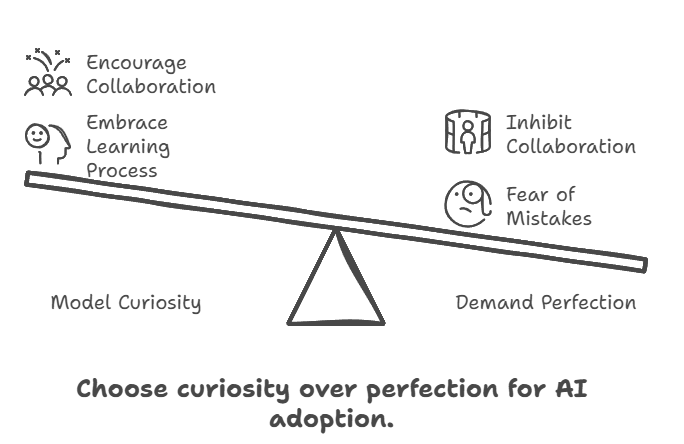You’re ready to bring AI into your team’s workflow—great.
But here’s the truth: introducing tools is the easy part.
The hard part? Coaching your team through the shift with confidence, clarity, and buy-in.
Because AI still feels overwhelming to some. Others worry it’ll make their roles obsolete. And some just don’t want to learn “another new thing.”
So how do you turn resistance into momentum—and curiosity into capability?
You lead.
And that starts with coaching, not commanding.
Here’s a practical guide to help you bring your team into the AI era—without friction or fear.

1. Start with Why—Not the Tech
→ Connect AI to the team’s pain points first
No one wants “a new tool.” But everyone wants less stress, less admin, and more meaningful work.
What you can do:
Ask your team: What’s draining your energy right now?
Then position AI as the tool that frees them from it.
✅ Practical example:
A content team I coached hated writing meeting summaries. We set up a ChatGPT prompt that auto-generated recaps from transcripts. Within a week, no one wanted to go back.
✨ Before/After:
- Before: Your team dreads writing follow-ups after meetings.
- After: AI handles the first draft. Your team reviews and sends in minutes.
Why focus on the tool, when you could focus on what it unlocks?
🧠 How I help:
In coaching, I help leaders uncover the real friction and map AI to solve it—so your rollout feels like relief, not disruption.
2. Pick One Use Case—And Win Early
→ Avoid overwhelm. Start with one clear, valuable win.
Big changes fail when you try to do everything at once.
What you can do:
Choose one task your team already hates (e.g., reporting, follow-ups, calendar blocking). Solve it with AI. Let them feel the difference.
✅ Practical example:
A founder I worked with started by using Motion to automate their daily schedule. After a week of feeling less overwhelmed, they introduced it to the whole team—with no pushback.
✨ Before/After:
- Before: Your day starts with 15 minutes of figuring out what to do.
- After: Your AI task manager builds your day for you.
Isn’t one clear win better than five half-baked experiments?
🧠 How I help:
I help you prioritize the lowest-effort, highest-return use cases—so your first win builds momentum.
3. Normalize Learning in Public
→ Encourage experimentation over perfection
People won’t use AI if they’re afraid of “getting it wrong.”
What you can do:
Be the first to share your messy prompts, weird outputs, and learnings. Make AI feel like a sandbox, not a test.
✅ Practical example:
One leadership team I coached started a weekly “Prompt Show & Tell” during their stand-up. Everyone shared what worked, what didn’t—and learned faster together.
✨ Before/After:
- Before: People experiment with AI in silence, unsure if they’re doing it “right.”
- After: Your team swaps tips, tests ideas, and grows their skill together.
What if your team saw AI learning as a game, not a guessing game?
🧠 How I help:
I create safe, hands-on workshops where your team builds AI confidence together—without pressure or shame.

4. Clarify What’s Not Changing
→ Reduce fear by reinforcing stability
Change creates uncertainty. And uncertainty often turns into resistance.
What you can do:
Reassure your team by clearly stating what AI won’t replace. Emphasize that human judgment, creativity, and empathy are still at the core.
✅ Practical example:
A marketing manager I coached introduced AI copywriting by saying, “We’re using AI for speed—but you’re still the voice of the brand.” It reframed the shift as empowerment, not threat.
Isn’t it easier to adapt when you know what’s not on the line?
🧠 How I help:
I coach leaders on crafting internal messaging that keeps teams calm, focused, and open to change.
5. Turn Curiosity Into Capability
→ Support the transition with training—not just tools
Giving your team ChatGPT access is not the same as helping them use it well.
What you can do:
Offer structure. Share use cases. Run live demos. Create templates. Build a system for sharing learnings.
✅ Practical example:
One SaaS company I work with built an “AI Playbook” for their team. It included prompt libraries, approved tools, and examples of use cases. Now, every team member has a head start.
If 52% of workers want AI training, why not be the manager who actually provides it?
🧠 How I help:
I design customized coaching programs and micro-trainings that meet your team where they are—without fluff or overwhelm.
You Don’t Need to Be the Expert. You Just Need to Lead.
AI isn’t a trend. It’s a shift.
Your team doesn’t need perfection. They need leadership—someone who can guide them through the unknown, stay curious, and champion smarter ways of working.
And when you coach them through this shift?
You don’t just adopt tools.
You unlock transformation.
Want Support Coaching Your Team Through the AI Shift?
You don’t have to do it alone. I help leaders like you:
- ✅ Run smooth, human-centered AI rollouts
- ✅ Get team buy-in without fear or overwhelm
- ✅ Turn AI into a daily advantage, not a buzzword
👉 Visit aicoachtobias.com to join the coaching program or hire me to guide your team through this shift—practically, confidently, and with zero code.
Let’s turn resistance into momentum.
🚀 Step Into AI Leadership Today
If you want to position yourself as a modern leader your team trusts and follows, now is the time to act.
Whether you’re exploring what’s possible or ready to lead an AI-driven transformation, I’ll help you build confidence, clarity, and real-world skills to future-proof your leadership style.
